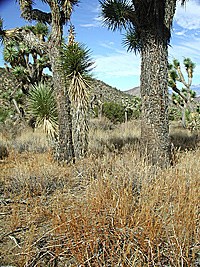
The home range of a plant species naturally changes over time, usually following climate change such as the recent ice age. What is not "natural," however, is the massive, global transportation of plant species on boats and planes by people traveling to distant lands. Over the last century, hundreds of new species have been introduced into the United States from every continent in the world. While many species are what we call "non-invasive," that is, you plant a rose in your garden and in general it doesn’t move on to your neighbor’s garden, many others are invasive. Tamarisk uses water needed by wildlife Located within remote wilderness areas of the park are a few small springs that emit a thin trickle of water. This water is vital to the survival of park wildlife. Yet, a few tamarisk seeds blow in, land in the moist sand, and before you know it this exotic invader has sucked the water deep below the surface and left the area dry, depriving other plants and wildlife this life-sustaining necessity. Fountaingrass competes with native grasses Cheatgrass and red brome carry fire Formerly when lightning struck a Joshua tree or juniper, it would consume that plant then burn out. Now the grasses covering the ground carry the fire from the ignited plant on to others. Desert plants are not adapted to fire; plant seeds do not require fire to break dormancy, nor do many of the plants resprout after fire. We believe that larger fires do occur in deserts, but historically only every century or so. Due to exotic grasses, we are now seeing large fires, such as the Juniper Complex fire that burned 14,000 acres in 1999, every five to 30 years in the Mojave. This is a big change in our ecosystem! Pursuing the invaders |
Last updated: June 10, 2023
